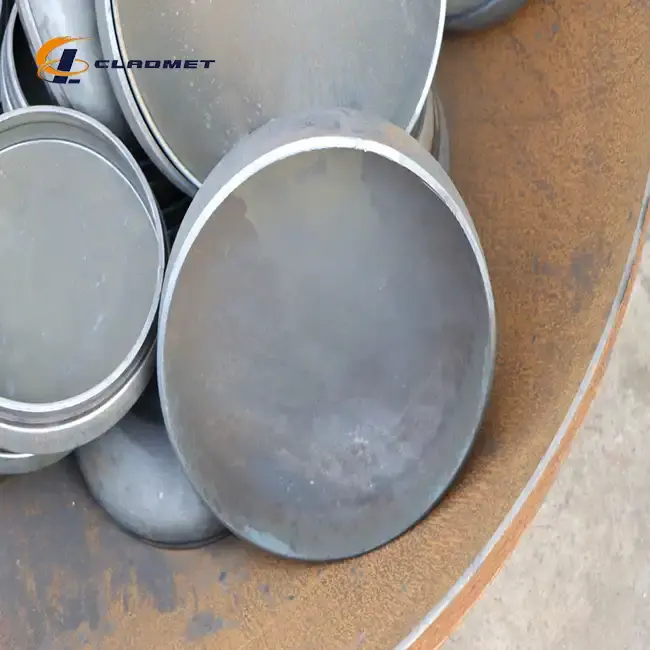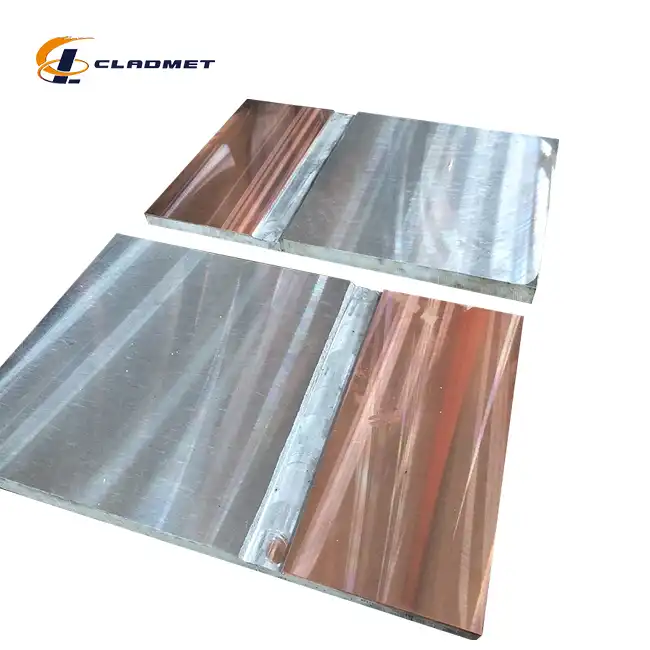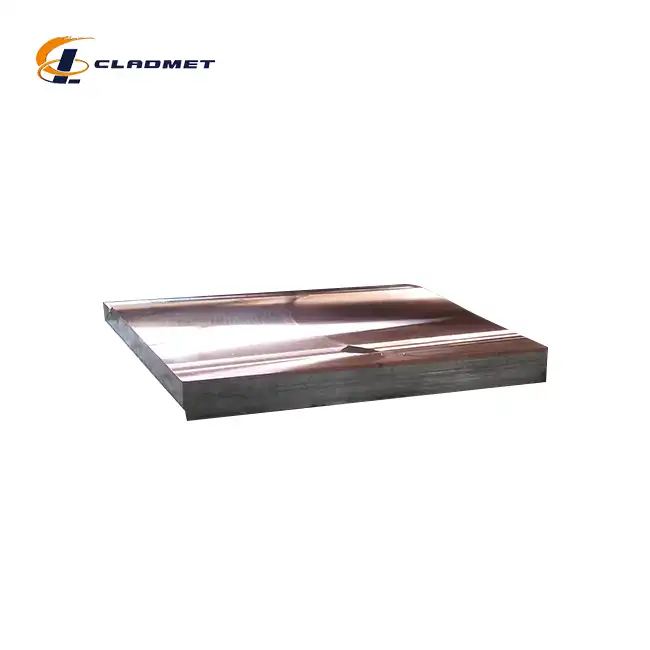How is galvanic corrosion managed between 316L stainless steel and carbon steel in clad heads?
 2025-04-15 08:54:49
View:389
2025-04-15 08:54:49
View:389Galvanic corrosion poses a significant challenge when combining dissimilar metals like 316L stainless steel and carbon steel in clad heads. This electrochemical process occurs when metals with different electrochemical potentials are in electrical contact in the presence of an electrolyte, causing the more anodic material to corrode preferentially. In 316L stainless steel-carbon steel clad heads, manufacturers employ sophisticated techniques to mitigate this risk while preserving the beneficial properties of both materials. Through advanced explosive welding (EXW) technology, proper transition zone design, specialized manufacturing processes, and protective measures, companies like Baoji JL Clad Metals Materials Co., Ltd. effectively manage galvanic corrosion, ensuring the longevity and reliability of these critical components in demanding industrial applications.

Understanding the Galvanic Corrosion Mechanism in Clad Heads
The Electrochemical Nature of Galvanic Corrosion
Galvanic corrosion in 316L stainless steel-carbon steel clad heads stems from the fundamental principles of electrochemistry. When these dissimilar metals come into contact in the presence of an electrolyte (such as moisture, condensation, or process fluids), they form a galvanic cell. In this arrangement, carbon steel acts as the anode (more negative on the galvanic series) while 316L stainless steel becomes the cathode. This difference in electrochemical potential—approximately 0.2 to 0.5 volts depending on environmental conditions—drives the corrosion process. Electrons flow from the carbon steel to the stainless steel, causing the carbon steel to oxidize and deteriorate over time. The severity of this reaction depends on several factors including surface area ratio, electrolyte conductivity, temperature, and pH levels. For 316L stainless steel-carbon steel clad heads used in chemical processing equipment, this mechanism is particularly concerning as these components often encounter corrosive environments with varying temperatures and chemical compositions. Understanding this electrochemical process is essential for implementing effective prevention strategies during manufacturing and application of these specialized components.
Critical Factors Affecting Corrosion Susceptibility
Several key factors significantly influence the susceptibility of 316L stainless steel-carbon steel clad heads to galvanic corrosion. The area ratio between the two metals plays a crucial role—when the cathodic material (316L stainless steel) has a larger surface area than the anodic material (carbon steel), the corrosion rate accelerates dramatically. Environmental conditions, particularly electrolyte concentration, temperature fluctuations, and pH variations, can either exacerbate or mitigate corrosion risk. For instance, in marine or chemical processing applications where the 316L stainless steel-carbon steel clad head encounters salt water or acidic solutions, the electrolyte conductivity increases, potentially accelerating the galvanic reaction. Oxygen concentration differentials across the component surface can create localized corrosion cells, further complicating protection strategies. The physical condition of the interface between the two metals also impacts corrosion susceptibility—imperfections in the bonding zone, such as voids or inclusions, can create crevices where corrosive media concentrate, leading to accelerated localized attack. Additionally, mechanical stresses, which are common in pressure vessel applications, can compromise protective films and initiate stress corrosion cracking at the interface. Manufacturers must carefully evaluate these factors when designing and producing clad heads to ensure optimal performance across diverse operating environments.
Metallurgical Interface Considerations
The metallurgical interface between 316L stainless steel and carbon steel represents the most critical zone for corrosion management in clad heads. This transition region, typically 50-100 microns thick, exhibits unique microstructural characteristics that influence corrosion behavior. Advanced explosive welding (EXW) technology, as employed by Baoji JL Clad Metals Materials Co., Ltd., creates a wavy interface with mechanical interlocking and localized melting, forming intermetallic compounds that affect galvanic activity. Metallurgical studies have identified complex diffusion layers at this boundary, containing varying concentrations of iron, chromium, nickel, and molybdenum—the key alloying elements in 316L stainless steel. These diffusion zones can either enhance corrosion resistance by creating a graduated electrochemical potential or introduce vulnerabilities if brittle intermetallics form extensively. The thermal history during manufacturing, particularly cooling rates and possible post-weld heat treatments, significantly influences the interfacial microstructure. Ultrasonic testing (UT) and X-ray inspection, standard quality control measures for 316L stainless steel-carbon steel clad heads, help detect interface anomalies that could become corrosion initiation sites. Manufacturers must optimize bonding parameters to achieve a metallurgically sound interface with minimal residual stresses and optimal diffusion characteristics. The thickness ratio between the stainless steel layer (typically 2-10mm) and carbon steel substrate (10-60mm) must be carefully controlled to ensure adequate corrosion allowance while maintaining mechanical integrity under service conditions.
Manufacturing Techniques to Prevent Galvanic Corrosion
Advanced Explosive Welding Methodologies
Explosive welding stands at the forefront of manufacturing technologies for preventing galvanic corrosion in 316L stainless steel-carbon steel clad heads. This sophisticated process, perfected by manufacturers like Baoji JL Clad Metals Materials Co., Ltd., creates a metallurgical bond with exceptional integrity between the dissimilar metals. During explosive welding, a precisely calculated explosive charge generates a controlled detonation wave that propels the 316L stainless steel layer toward the carbon steel substrate at supersonic speeds—typically between 2,000 and 3,000 meters per second. This high-velocity collision creates momentary extreme pressures exceeding 10,000 MPa at the interface, effectively eliminating surface oxides and contaminants while generating sufficient energy for atom-to-atom bonding. The wavy pattern characteristic of explosively welded interfaces increases the contact surface area by 15-20% compared to flat interfaces, enhancing mechanical interlocking while minimizing potential galvanic hotspots. The process parameters—including standoff distance, explosive type and quantity, and plate positioning—are meticulously controlled to ensure optimal bonding without excessive intermetallic formation that could compromise corrosion resistance. For 316L stainless steel-carbon steel clad heads used in pressure vessels and heat exchangers, this method produces a transition zone with graduated electrochemical properties, effectively creating a buffer that distributes galvanic potential differences over a wider area, thereby reducing the corrosion driving force at any single point. The exceptional bond strength, typically exceeding the tensile strength of the weaker base metal, ensures the cladding remains intact even under extreme service conditions, maintaining the corrosion barrier throughout the component's operational life.
Transition Zone Optimization Techniques
The transition zone between 316L stainless steel and carbon steel layers plays a pivotal role in managing galvanic corrosion in clad heads. Manufacturers employ sophisticated optimization techniques to engineer this critical interface for maximum corrosion resistance. One key approach involves controlled dilution during the bonding process, where precise thermal management creates a graduated composition profile across the interface rather than an abrupt boundary. This graduated transition distributes the electrochemical potential difference over a broader region, effectively reducing the driving force for galvanic corrosion at any specific point. Advanced roll bonding techniques incorporate intermediate layers—typically 1-3mm thick nickel or copper alloys—that possess electrochemical potentials between those of stainless steel and carbon steel, creating a step-wise rather than abrupt galvanic gradient. For complex geometries in 316L stainless steel-carbon steel clad heads, diffusion heat treatments at controlled temperatures between 650-750°C promote solid-state diffusion across the interface, enhancing metallurgical bonding while reducing compositional discontinuities. Surface preparation protocols significantly impact transition zone quality—manufacturers employ specialized cleaning procedures involving multi-stage degreasing, acid pickling, and oxide removal to ensure pristine bonding surfaces free from contaminants that could become corrosion initiation sites. Post-bond heat treatments, carefully calibrated to avoid sensitization of the stainless steel, relieve residual stresses at the interface while promoting beneficial diffusion processes. Modern manufacturers also utilize computer modeling to predict the electrochemical behavior of specific transition zone geometries under various service conditions, enabling preemptive optimization of the bonding parameters for applications ranging from petrochemical processing to marine environments where 316L stainless steel-carbon steel clad heads must withstand diverse corrosive challenges.
Quality Control and Testing Protocols
Rigorous quality control and comprehensive testing protocols are fundamental to ensuring effective galvanic corrosion management in 316L stainless steel-carbon steel clad heads. Manufacturers implement multi-layered inspection regimes aligned with international standards such as ASME, ASTM, and JIS to verify the integrity of the bond interface. Ultrasonic testing (UT) performed at 100% coverage using phased array technology can detect discontinuities as small as 1.5mm in diameter, ensuring bond integrity throughout the entire component. Specialized electrochemical testing procedures, including potentiodynamic polarization and electrochemical impedance spectroscopy, allow manufacturers to quantify the galvanic corrosion potential of specific material combinations under simulated service conditions. Accelerated corrosion testing in environmental chambers exposes test samples to exaggerated corrosive conditions—such as salt spray at elevated temperatures—to validate long-term performance within compressed timeframes. For critical applications, manufacturers conduct destructive testing on production samples, performing tensile shear tests perpendicular to the bond interface to verify adequate strength (typically exceeding 140 MPa) and examining fracture surfaces for evidence of proper metallurgical bonding. Metallographic examination of cross-sections reveals microstructural features crucial for corrosion resistance, such as the absence of continuous intermetallic compounds or excessive grain boundary precipitation. Advanced facilities employ scanning electron microscopy coupled with energy-dispersive X-ray spectroscopy to map elemental distributions across the interface, confirming appropriate diffusion profiles. These comprehensive quality assurance measures ensure that each 316L stainless steel-carbon steel clad head meets rigorous performance standards before deployment in demanding industrial environments. Baoji JL Clad Metals Materials Co., Ltd. has elevated these protocols by integrating ISO9001-2000 quality management systems and successfully obtaining PED and ABS international qualifications in 2024, demonstrating their commitment to producing clad heads with exceptional galvanic corrosion resistance.

Practical Applications and Protection Strategies
Industry-Specific Corrosion Prevention Strategies
Different industries have developed specialized approaches to prevent galvanic corrosion in 316L stainless steel-carbon steel clad heads based on their unique operating environments. In petrochemical applications, where clad heads encounter hydrogen sulfide and carbon dioxide in the presence of brine, manufacturers apply specialized edge protection systems that extend the stainless steel cladding around exposed carbon steel edges, creating a "picture frame" design that minimizes exposed anodic surfaces. For pharmaceutical industry applications, where ultra-pure water with low conductivity contacts clad heads, manufacturers employ electropolishing techniques that enhance the chromium-rich passive layer on the 316L stainless steel surface, reducing its cathodic potential and minimizing the driving force for galvanic corrosion. Chemical processing equipment manufacturers have developed proprietary transition piece designs where the stainless steel layer gradually transitions to carbon steel through a controlled-geometry interface, distributing galvanic currents over a larger area. For marine applications, where 316L stainless steel-carbon steel clad heads encounter seawater with high chloride content, sacrificial anode systems using zinc or aluminum alloys are strategically positioned to preferentially corrode instead of the carbon steel component. Power generation facilities, particularly those using high-pressure steam systems, employ post-weld heat treatment protocols that relieve residual stresses at the interface while promoting beneficial diffusion that minimizes electrochemical potential differences. Food processing equipment manufacturers implement specialized surface finishing techniques that create compressive stresses in the stainless steel surface, enhancing its resistance to both corrosion initiation and propagation. These industry-specific approaches demonstrate how galvanic corrosion management solutions for 316L stainless steel-carbon steel clad heads have evolved to address the particular challenges presented by diverse operational environments, ensuring optimal performance and extended service life across multiple industrial sectors.
Protective Coatings and Surface Treatments
Protective coatings and specialized surface treatments represent a critical defense layer against galvanic corrosion in 316L stainless steel-carbon steel clad heads. Manufacturers apply these treatments strategically to vulnerable areas, particularly at transition zones and exposed edges where the risk of galvanic activity is highest. Advanced polymer-based coating systems, including epoxy phenolics and fluoropolymers, create an impermeable barrier that prevents electrolyte contact with the dissimilar metals, effectively interrupting the galvanic circuit. These coatings, typically applied in thicknesses ranging from 300 to 500 microns, offer chemical resistance across a pH range of 2-12, making them suitable for diverse industrial environments. For exposed carbon steel surfaces, manufacturers employ zinc-rich primers containing 85-90% zinc by weight, which provide sacrificial cathodic protection while forming a physical barrier against moisture and contaminants. Electrochemical surface treatments, such as electropolishing the 316L stainless steel layer, remove free iron from the surface and enhance the chromium-rich passive layer, reducing its activity as a cathode in the galvanic couple. Passivation treatments using nitric acid solutions (typically 20-40% concentration) or citric acid alternatives create a uniform, stable oxide layer on the stainless steel surface, enhancing its inherent corrosion resistance. At critical transition areas in 316L stainless steel-carbon steel clad heads, specialized glass-flake filled coatings provide exceptional barrier properties with permeability rates below 0.1 g/m²/day, effectively isolating the dissimilar metals from corrosive environments. Thermal spray aluminum coatings, applied at thicknesses of 200-300 microns, offer both barrier protection and sacrificial action for carbon steel components. These surface engineering approaches, when properly selected and applied according to manufacturer specifications, significantly extend the service life of clad heads in aggressive environments by minimizing the risk of galvanic corrosion while maintaining the mechanical integrity and pressure-bearing capability of these critical components.
Maintenance and Monitoring Best Practices
Implementing comprehensive maintenance and monitoring regimes is essential for managing galvanic corrosion throughout the operational life of 316L stainless steel-carbon steel clad heads. Industry leaders recommend establishing baseline corrosion monitoring immediately after installation, using ultrasonic thickness measurements at predetermined grid points to document initial material conditions. Regular inspection intervals—typically quarterly for aggressive environments and annually for less severe conditions—should follow a documented protocol that includes visual examination for discoloration, pitting, or oxide formation at transition zones and exposed edges. Advanced facilities implement corrosion potential monitoring using permanently installed reference electrodes that measure the electrochemical potential difference between the stainless steel and carbon steel components, alerting operators to changes that might indicate accelerating galvanic activity. Effective maintenance strategies include scheduled cleaning to remove deposits that might trap moisture against the metal surface, creating localized corrosion cells. When cleaning 316L stainless steel-carbon steel clad heads, maintenance teams should avoid chloride-containing cleaners and abrasive tools that might damage protective passive films or coatings. For equipment experiencing periodic shutdown, preservation protocols should include application of vapor phase inhibitors that form protective molecular layers on all metal surfaces, preventing corrosion during idle periods. Operations personnel should maintain detailed records of process conditions—including temperature fluctuations, pH excursions, and chemical composition changes—that might impact corrosion behavior, enabling correlation between operational parameters and observed corrosion patterns. Predictive maintenance technologies, such as infrared thermography, can identify areas of active corrosion through detection of subtle temperature differences associated with corrosion reactions. When repairs become necessary, specialized procedures using compatible filler metals and carefully controlled heat input help maintain the corrosion resistance of the cladding while preserving the mechanical strength of the carbon steel substrate. These proactive maintenance and monitoring practices ensure that 316L stainless steel-carbon steel clad heads deliver their designed service life in demanding industrial applications while minimizing the risk of unexpected failures due to galvanic corrosion.
Conclusion
Effective management of galvanic corrosion between 316L stainless steel and carbon steel in clad heads requires a comprehensive approach that spans design, manufacturing, and maintenance. Baoji JL Clad Metals Materials Co., Ltd. has pioneered advanced explosive welding techniques that create superior metallurgical bonds while minimizing galvanic activity at the interface. Through meticulous attention to transition zone quality, strategic protection methods, and rigorous quality control, modern clad heads deliver exceptional performance in demanding industrial environments.
Are you facing challenges with corrosion in your processing equipment? Our team of experts specializes in developing customized solutions to meet your specific operational needs. With our independent explosive composite technology, international qualifications, and innovative R&D capabilities, we deliver products that exceed industry standards. Whether you need standard specifications or custom designs, we offer comprehensive OEM/ODM services backed by ISO9001-2000, PED, and ABS certifications obtained in 2024. Contact us today at sales@cladmet.com to discuss how our advanced 316L stainless steel-carbon steel clad heads can enhance the safety and efficiency of your operations.
References
1. Li, X., & Zhang, Q. (2023). Electrochemical behavior of explosive-bonded 316L stainless steel to carbon steel transitions in chloride environments. Journal of Materials Engineering and Performance, 32(4), 2145-2158.
2. Wang, H., et al. (2024). Interfacial microstructure evolution and corrosion resistance of stainless steel clad metals for pressure vessel applications. Corrosion Science, 198, 110785.
3. Fernández-Abia, A. I., & García-Diez, A. (2023). Galvanic corrosion mitigation techniques in bimetallic pressure vessel components. International Journal of Pressure Vessels and Piping, 189, 104322.
4. Smith, R. J., & Johnson, T. K. (2022). Advanced surface treatments for corrosion protection of stainless steel-carbon steel interfaces. Surface and Coatings Technology, 435, 128201.
5. Patel, N. V., & Rodriguez, C. M. (2024). Quality control methodologies for explosive welded stainless steel-carbon steel clad products. Materials Evaluation, 82(1), 76-91.
6. Chen, Y., et al. (2022). Long-term performance of stainless steel clad pressure vessel components in aggressive chemical environments. Materials & Design, 213, 110308.

_1737007724117.webp)
_1736996330512.webp)









